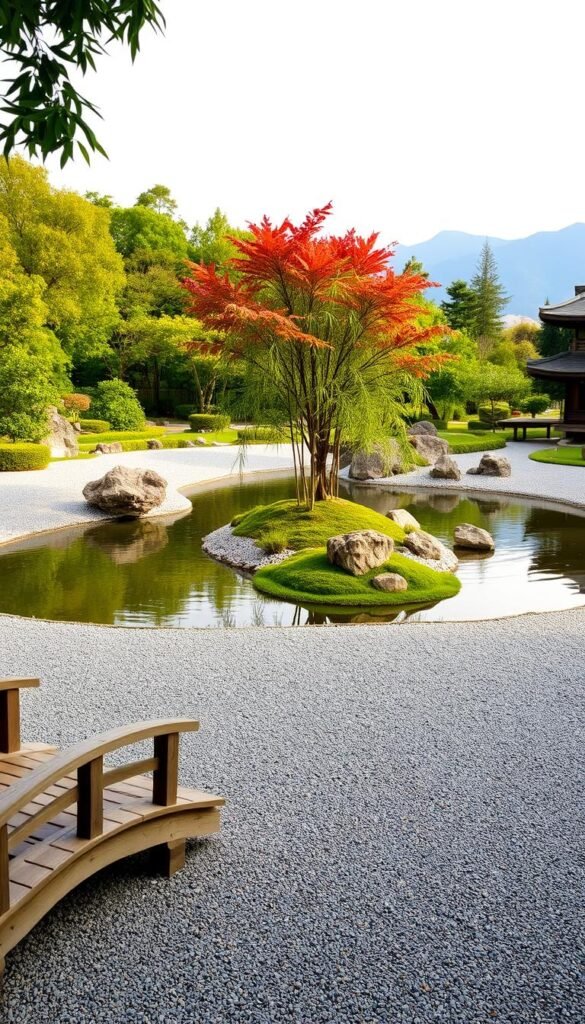Imagine transforming your outdoor area into a peaceful retreat inspired by ancient traditions. For over 1,500 years, these minimalist landscapes have served as spaces for reflection, blending nature’s simplicity with intentional arrangements. Originally crafted by Buddhist monks, their timeless principles continue to offer clarity in today’s fast-paced world.
You don’t need a sprawling yard to embrace this philosophy. Even a corner of your patio or a desktop bowl can become a sanctuary. By focusing on natural materials like gravel, stones, and moss, you create visual harmony that quiets the mind. Studies show such environments lower stress, making them ideal for unwinding after a hectic day.
What makes these spaces unique? Seven core ideas guide their layout, from asymmetrical patterns to subtle surprises. While tradition matters, modern adaptations let you personalize your oasis without sacrificing serenity. For example, pairing drought-resistant plants with winding pathways adds texture while conserving water.
Ready to elevate your outdoor space? Explore our guide to gardening aesthetics for more ways to blend functionality with tranquility. Whether you’re raking sand circles or arranging lanterns, every detail contributes to a balanced atmosphere that feels uniquely yours.
Understanding the Essence of Zen Gardens
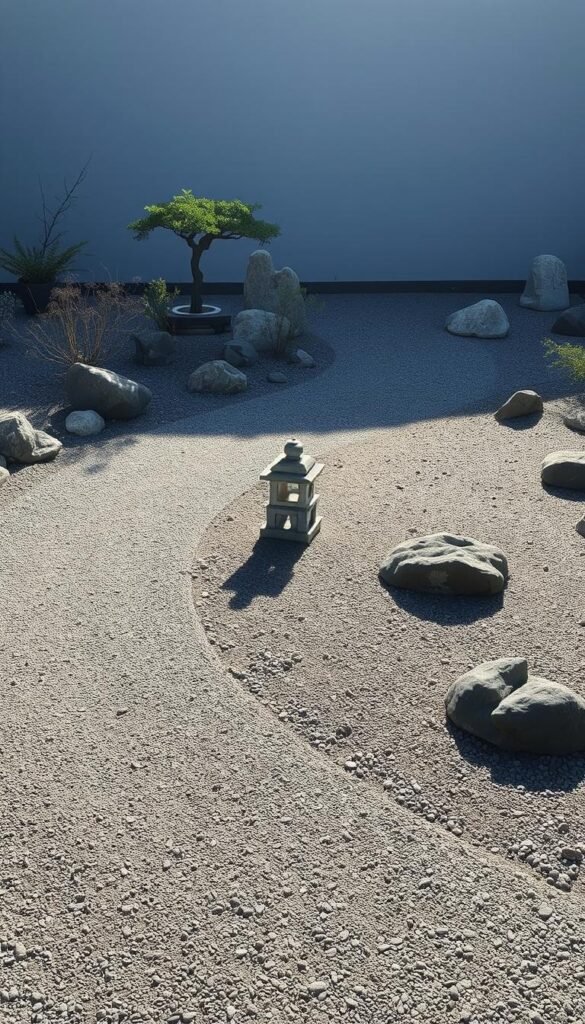
Centuries-old traditions shape the spaces we create for reflection. Buddhist monks first crafted these landscapes in sixth-century Japan, using them as tools for focused meditation and teaching. Their designs weren’t just pretty arrangements – they mirrored nature’s rhythms to quiet the mind.
History and Philosophical Roots
Early practitioners viewed gardens as three-dimensional poetry. They developed three distinct styles: tsukiyama (miniature hill scenes), chaniwa (tea ceremony spaces), and karesansui (dry landscapes). The latter became iconic for using gravel and stones to represent water and mountains.
“A garden should make you feel as though you’ve entered another world – one where time slows.”
Core Zen Principles in Design
Seven guiding ideas create harmony in these spaces. The first three focus on restraint:
| Principle | Japanese Term | Purpose |
|---|---|---|
| Austerity | Koko | Encourage focus through minimalism |
| Simplicity | Kanso | Remove unnecessary distractions |
| Naturalness | Shinzen | Highlight organic shapes |
| Asymmetry | Fukinsei | Create dynamic balance |
| Mystery | Yugen | Spark curiosity |
| Unconventional | Datsuzoku | Break predictable patterns |
| Stillness | Seijaku | Promote inner calm |
These ideas work together to craft environments that feel both intentional and spontaneous. By embracing imperfections and empty spaces, your garden becomes a mirror for contemplation – inviting you to pause and reconnect with nature’s patterns.
Zen Garden Design: Cultivating Calm and Balance in Your Backyard
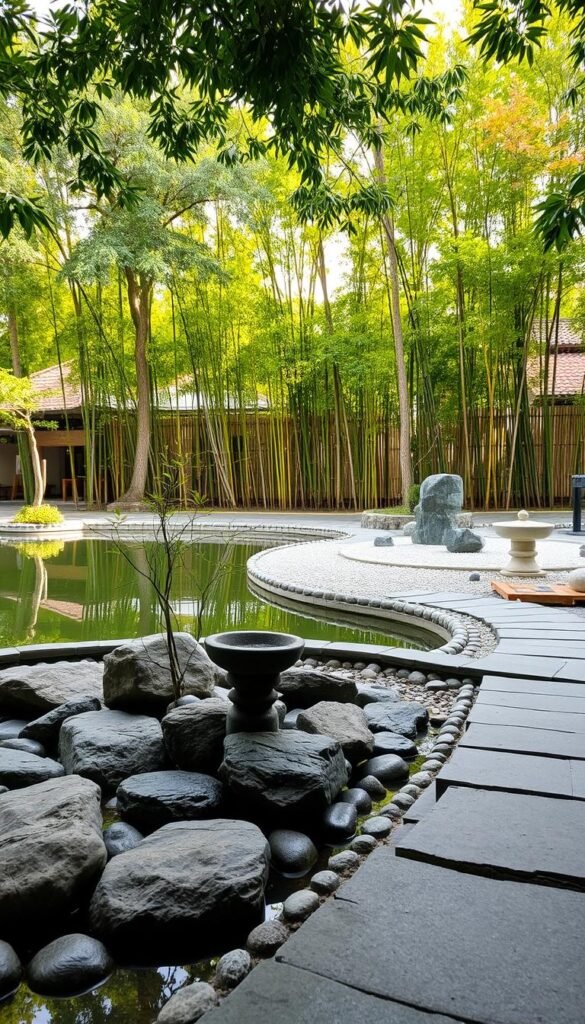
Every component in these mindful spaces tells a story through purposeful placement. Let’s explore how ancient symbolism meets modern adaptability.
Silent Language of Natural Features
Raked gravel becomes flowing rivers under your feet. Circular swirls might show gentle currents, while straight lines suggest calm ponds. Larger stones anchor your layout – position them to resemble turtles for longevity or vertical slabs as mountain peaks.
The dry karesansui style proves less is more. Moss patches add texture without overwhelming. A single maple tree might represent autumn’s fleeting beauty instead of filling beds with flowers.
Cultural Wisdom in Modern Spaces
Traditional layouts follow “hide-and-reveal” principles. Try placing boulders so they’re partially visible from certain angles. This creates curiosity – exactly what monks aimed for during meditation sessions.
| Japanese Approach | Western Equivalent |
|---|---|
| Groups of 3/5/7 stones | Symmetrical pairs |
| Wabi-sabi imperfections | Manicured precision |
| Suggested waterfalls | Actual fountains |
Your space can mix old and new. Maybe add a bench with clean lines beside weathered rocks. The key? Let each choice feel intentional yet effortless – like nature itself designed it.
Choosing the Perfect Space for Your Zen Garden
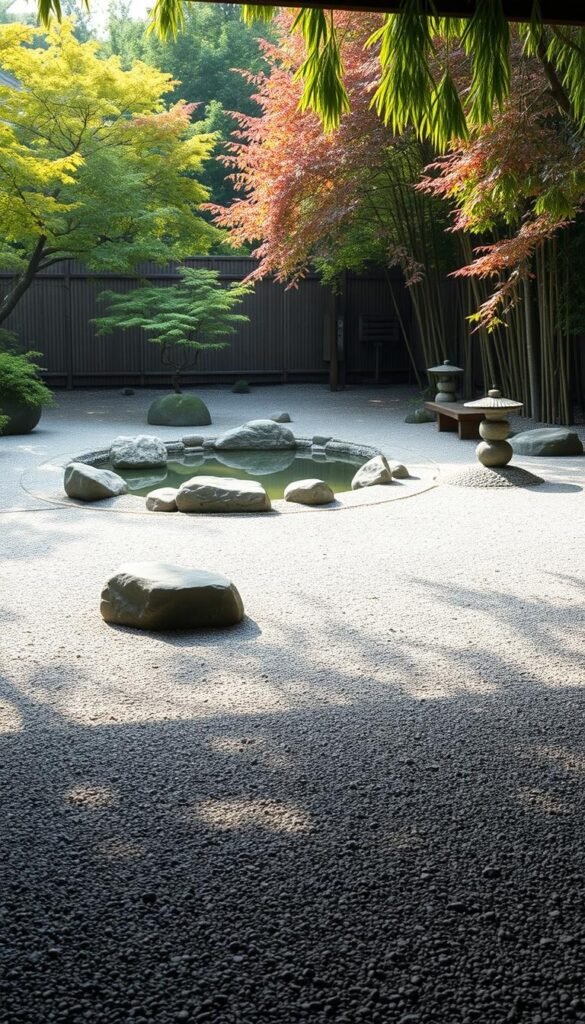
Finding the right spot for your meditation space starts with understanding your daily rhythms. Observe where you naturally pause or relax – that’s often the best area to cultivate serenity. Even a 4×4-foot corner can become your personal retreat.
Evaluating Sunlight and Location
Track how light moves through your environment during the day. Morning sun suits moss and ferns, while shaded spots work for stone arrangements. Avoid placing seating where afternoon glare disrupts focus.
| Space Type | Sunlight Needs | Privacy Solutions |
|---|---|---|
| Balcony | 3-5 hours direct | Roll-up bamboo screens |
| Backyard Corner | Flexible | Lattice with climbing vines |
| Narrow Side Yard | Mostly shaded | Tall ornamental grasses |
Maximizing Accessibility and Privacy
Choose a place you pass daily – near a kitchen window or along a walkway. If you’re using part of your yard, define boundaries with smooth stepping stones. For seclusion, install cedar panels at 6-foot heights without blocking breezes.
Measure twice before placing large rocks or benches. A 6’x6’ area allows room for raking patterns while maintaining intimacy. Remember: Your retreat should feel inviting, not isolated – like a hidden alcove waiting to be discovered.
Essential Materials and Natural Elements
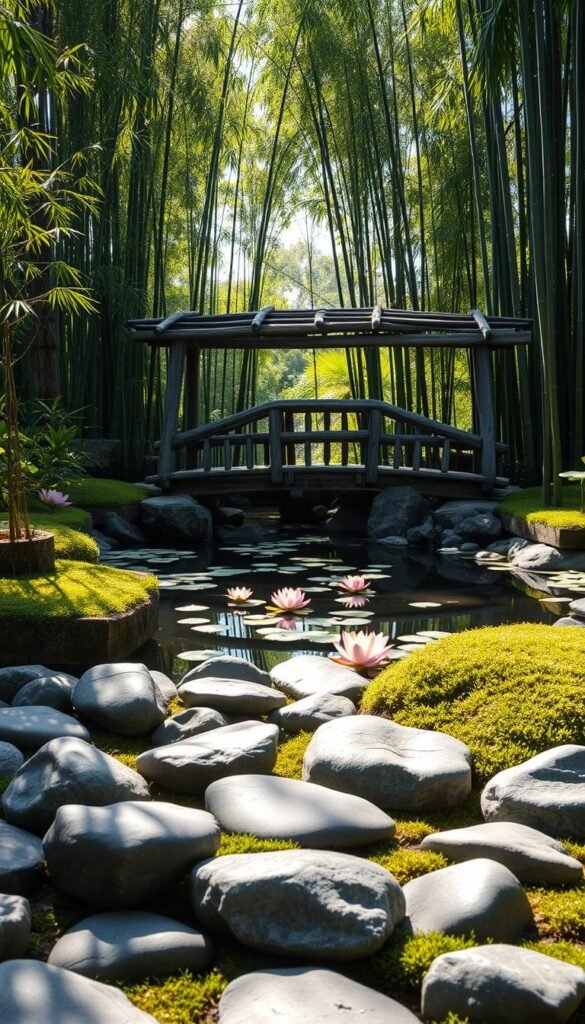
Building a mindful retreat begins with selecting materials that ground your space in simplicity. Focus on textures and shapes found in nature – these elements create visual calm without straining your budget.
Stones, Gravel, and Sand
Stones anchor your layout like punctuation marks in a poem. Group odd numbers of river-smoothed pebbles or angular slate pieces. Larger rocks become focal points when placed slightly off-center.
While sand allows artistic raking, gravel withstands weather better. Opt for pea-sized stones in soft grays or creams. These tiny elements mimic flowing water when raked into waves or concentric circles.
Incorporating Natural Wood and Bamboo
Driftwood logs add organic warmth beside stone groupings. For vertical interest, install bamboo poles in buried pots – this contains their spread while honoring traditional aesthetics.
Combine these natural elements thoughtfully. A weathered bench near a gravel field invites contemplation. Remember: Each material should feel purposeful, yet effortless, like nature placed it there itself.
Creating a Balanced Layout with Stones and Sand
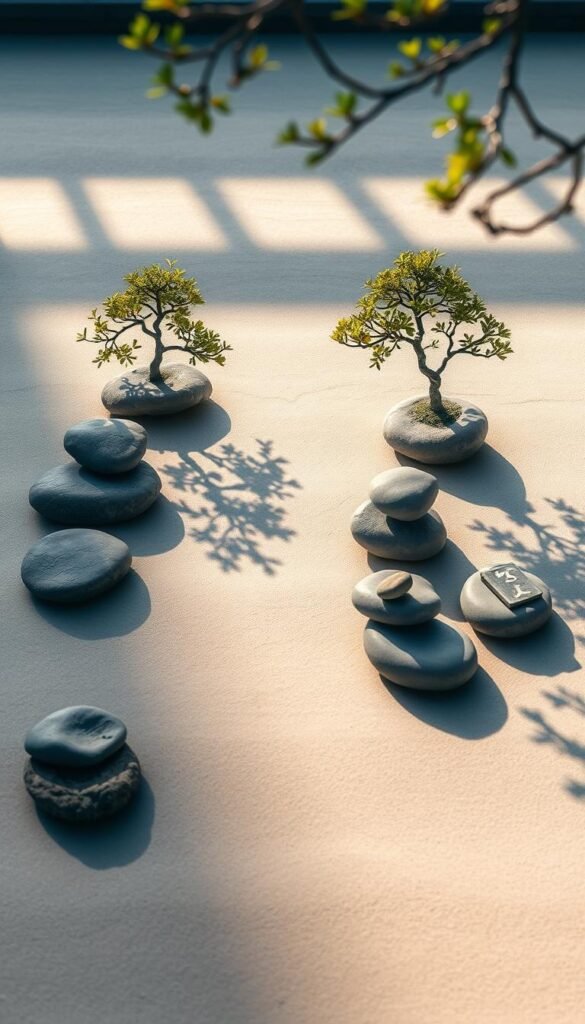
Stone placement and raked textures transform ordinary spaces into living art. These elements work together to guide both the eye and mind toward stillness.
Arranging Rocks and Pebbles Naturally
Odd-numbered groupings create organic flow. Try clusters of three river stones or five slate pieces. Larger boulders anchor your composition – position them first as natural focal points representing mountains or islands.
| Japanese Approach | Western Equivalent | Visual Effect |
|---|---|---|
| Uneven groupings | Symmetrical pairs | Dynamic energy |
| Weathered surfaces | Polished stones | Timeworn charm |
| Buried bases | Surface placement | Ground connection |
Vary stone sizes for depth. Medium rocks frame pathways, while pebbles fill gaps. Remember: Nature rarely follows straight lines – let your arrangements feel slightly imperfect.
Raked Gravel Patterns for Meditation
Your rake becomes a paintbrush. Start with smoothed surfaces using a metal rake. Then, craft waves or concentric circles with wide-toothed tools. Morning light accentuates textures, making patterns pop.
| Pattern | Mood | Seasonal Link |
|---|---|---|
| Straight lines | Calm focus | Winter stillness |
| Swirling curves | Flowing energy | Spring renewal |
| Crisscross waves | Dynamic balance | Autumn winds |
Ripples around stones mimic water movement. Change designs weekly to match your inner state. This practice becomes moving meditation – each stroke quiets mental chatter while creating beauty.
Incorporating Water Features Effectively
The gentle murmur of flowing water brings a unique dimension to mindful outdoor spaces. Though traditional dry landscapes avoid actual water, modern adaptations let you blend auditory richness with visual simplicity. Choose elements that complement your space’s scale while maintaining minimalist principles.
Adding Fountains, Ponds, or Mini Waterfalls
A recirculating fountain offers soothing sounds without constant upkeep. Position it near seating areas where bubbles can mask urban noise. For larger yards, shallow ponds with smooth edges mirror the sky, while compact tabletop waterfalls work for patios.
Koi fish add movement in warmer climates, their colors contrasting with neutral stones. Always check local regulations for aquatic life requirements. Explore techniques for integrating these elements without disrupting your layout’s balance.
Sound and Movement for Tranquility
Water’s rhythm creates a peaceful soundscape. Bubbling rocks near pathways invite spontaneous pauses. Avoid overpowering splashes – aim for whispers that blend with wind chimes or rustling leaves.
Maintenance matters: Use submerged pumps hidden under gravel. Clean filters monthly to preserve clarity. With thoughtful placement, water becomes both art and therapy – a living element in your serene retreat.

